Welcome to today’s edition of ShentonSTAGE Daily.
Lift your razor high, Sweeney!
In my newsletter on Friday, I pointed out that the composers of the two shows I saw press performances of back-to-back in New York last Wednesday both shared birthdays that day: Andrew Lloyd Webber turning 75, while Stephen Sondheim would have turned 93.
It\s unquestionably true that though Lloyd Webber and Sondheim have together dominated the Broadway musical for more than seven decades and counting, Lloyd Webber’s standing and currency is rapidly fading, with dismal reviews for his latest show BAD CINDERELLA after it officially opened last Thursday, while Sondheim’s standing just grows and grows.
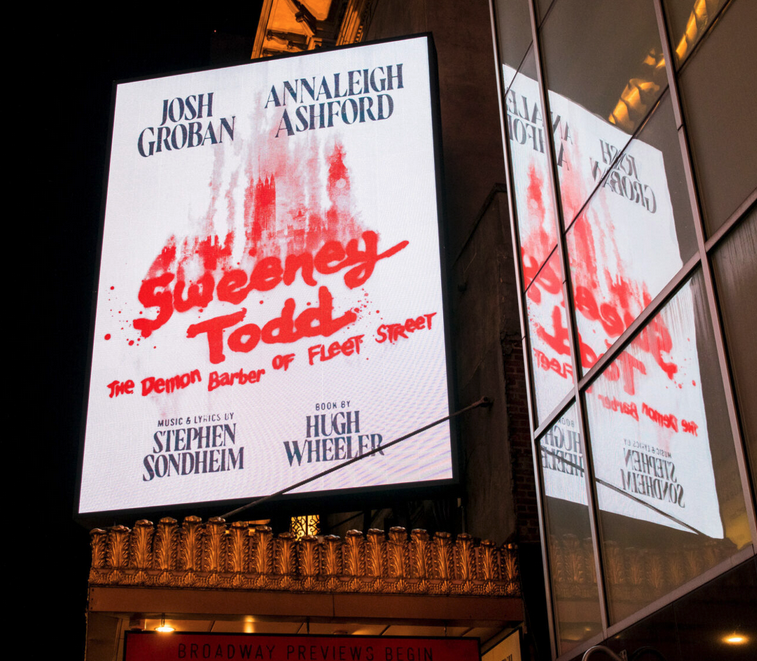
Last night saw the arrival of a new production of arguably Sondheim’s greatest masterpiece SWEENEY TODD, originally premiered at the Uris (now the Gershwin) in 1979. This production marks its third Broadway revival since then, after smaller-scale incarnations at the Circle in the Square in 1989 (using just a three-person synthesizer band) and a revival at the Eugene O’Neill in 2005 that featured just 10 actor-musicians. I’ve also seen Manhattan revivals at New York City Opera (by original director Hal Prince) and Off-Broadway at Barrow Street Theatre, when the Tooting pie shop production transferred there from London.
In a recent preview feature in the New York TImes, it was noted that, “With a capitalization of $13.5 million, a company of 25 actors and an orchestra of 26 players, this is Sweeney as it hasn’t been seen or heard on Broadway for 43 years. We’re used to Sweeney Todd deconstructed. Can it be reconstructed?”
Lead producer Jeffrey Seller — also behind HAMILTON across the street — is quoted saying,
“Does New York need or want another Sweeney Todd, only four or five years after the pie shop? And the answer was: Maybe, if we give them something they haven’t seen in 40 years, a full-scale production with a full ensemble and a full orchestra.”
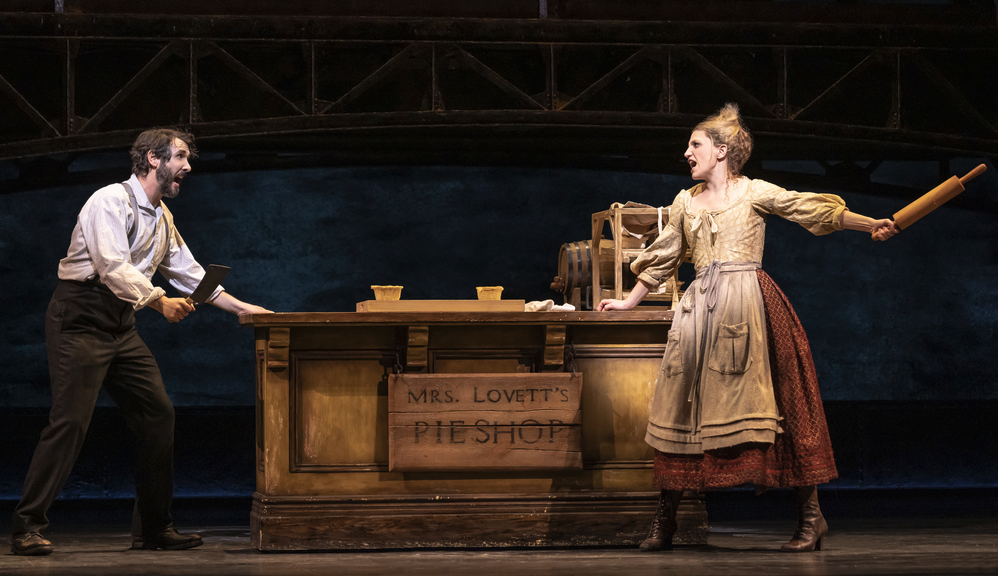
The show’s epic operatic grandeur has been fully and gloriously restored. And, as sung by Josh Groban (above left), this is the best-sounding Sweeney Todd New York has ever heard, only matched by Michael Cerveris who played the role in 2005. He is ideally partnered by Annaleigh Ashford as an earthy, spirited Mrs Lovett (above right), lending a production that is overwhelmingly dark (in every sense) its few moments of radiant lightness and genuine hilarity. (The lighting plot is often so dark that I wondered if people sitting further back than I was in the twelfth row of the stalls would make out much in the often-prevailing gloom).
For a musical about a serial killer and his amoral accomplice, this is a score of swooning romanticism; even as Sweeney is cutting the throats of his unfortunate customers in his tonsorial parlour, he is singing a haunting ode to the memory of his daughter Johanna. With the music supervised and conducted by Alex Lacamoire, Sondheim’s gorgeous score is given its full, thrilling power.
While smaller productions of the show have also provided valuable insights into its expert dramatic architecture, it is only when seeing and hearing it at this level that the full intensity of it can be experienced. As such, it is an unmissable production.
Today’s reviews mostly affirm this; in his review for the New York Times, Jesse Green reveals how his parents actually made a modest profit off investing in the original production. “Full disclosure: My parents, responding to an ad in The Times in 1978, invested $1,800 in the original production, and after 10 or 15 years earned a profit of, I think, $80. But even putting that windfall aside, I have never not loved Sweeney.”In a pie shop or a foundry, I am always transported, largely by the music, to a place where grief twists people into nightmares, and others find ways to monetize that. I hope the current producers likewise find ways to monetize Kail’s production, because what is Broadway for if not a Sweeney that, however rare, is this well-done?”
Are musicals really killing theatre?
In a diary column in The Spectator last week, playwright David Hare wrote expressing his dismay upon “passing Wyndham’s, by far the most perfect playhouse in London for the spoken word. Squatting there was yet another musical, the one the profession nicknames Wokelahoma. Musicals have become the leylandii of theatre, strangling everything in their path. It’s a crushing defeat to see Wyndham’s without a straight play. Is it our fault? Are dramatists not writing enough good plays which can attract 800 people a night? Will well-known actors not appear in them? Or did producers mislay their balls during lockdown?”

But as Michael Billington pointed out in a reply in The Guardian, regarding Hare being affronted by Oklahoma! occupying Wyndheim’s,
“Director Daniel Fish, however, has done precisely what the best directors of classic plays have been doing for ages: he gives us a fresh perspective on a familiar work without (well, almost without) altering the text. Instead of the usual gung-ho hymn to rural America, we get a dark, disturbing study of the victimisation of the outsider – in this case Jud Fry – by a small, self-regarding community.”
Hare, who has had much of his career supported and nurtured by the subsidised theatre, particularly at the National where he was virtually the resident house playwright for a time, also misses the point that Wyndham’s is a COMMERCIAL theatre, available to rent to the best bidder (in the opinion of the theatre owner, in this case Cameron Mackintosh’s Delfont Mackintosh group). Musicals simply make more money than plays — though they also cost more to put on, too — therefore producers and theatre owners look for that.
Of course a healthy theatre ecology has both plays and musicals. And sure, some long-running shows — mainly, these days, musicals — outstay their welcome, taking up real estate and preventing other newer product to find a place to showcase themselves. But if a show in the commercial theatre, whether it be THE MOUSETRAP, THE WOMAN IN BLACK or THE PLAY THAT GOES WRONG, or LES MISERABLES, THE PHANTOM OF THE OPERA, MAMMA MIA! or WICKED, can still generate money, they’re entitled to stay! It’s not for Hare to police what can and can’t take space in the West End.
In a letter published in The Times on Saturday, Hare sought to clarify his remarks: “I did not dispute the quality of musicals. Guys and Dolls is a blazing masterpiece, and Hamilton is a cracker. I questioned their ubiquity. Commercial theatre makes most impact when it offers a rich mix of the spoken and the sung. Since Covid, the balance is skewed.”
That may well be the case right now, with traditional playhouses like Wyndham’s and its neighbour the Coward currently occupied by musicals. But neither are open-ended runs; THE GREAT BRITISH BAKE-OFF MUSICAL at the Coward will be replaced by the transfer of Peter Morgan’s PATRIOTS, transferring from the Almeida, from May 26.
On Shaftesbury Avenue, musicals and plays regularly cycle alternately through the Lyric, Apollo and Gielgud. The Lyric currently has 2: 22 A GHOST STORY, to be followed by a limited run new production for Lloyd Webber’s ASPECTS OF LOVE and then PETER PAN GOES WRONG; at the Apollo, the play FOR COLORED BOYS…. (opening this week) will be followed by a new British musical THE TIME TRAVELLERS’ WIFE; and at the Gielgud, the current TO KILL A MOCKINGBIRD will be followed by STEPHEN SONDHEIM’S OLD FRIENDS. The balance that Hare feels is out of kilter is in fact very much there already.
RIP, NIck Lloyd Webber and Janine Shalom
Last week Andrew Lloyd Webber issued a statement that he would not be attending Thursday’s Broadway opening of BAD CINDERELLA, owing to the terminal illness of his eldest son Nick. On Saturday came another statement that Nick had died, aged 43.
It does rather put the poor critical reception for BAD CINDERELLA in New York into perspective. It’s only a show, after all.
And last night came news, via Twitter, of the passing of veteran West End press agent, Janine Shalom, head of PR at Premier PR (and previously head of press at the Almeida and before that a long-time staffer in the National’s in-house press office).
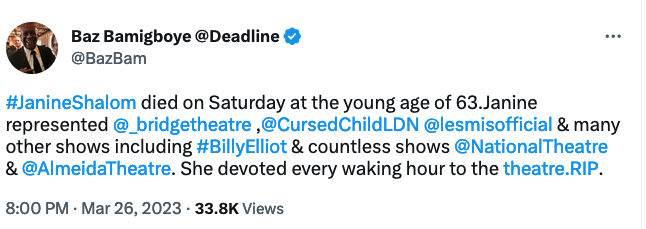
As producer Sonia Friedman tweeted,
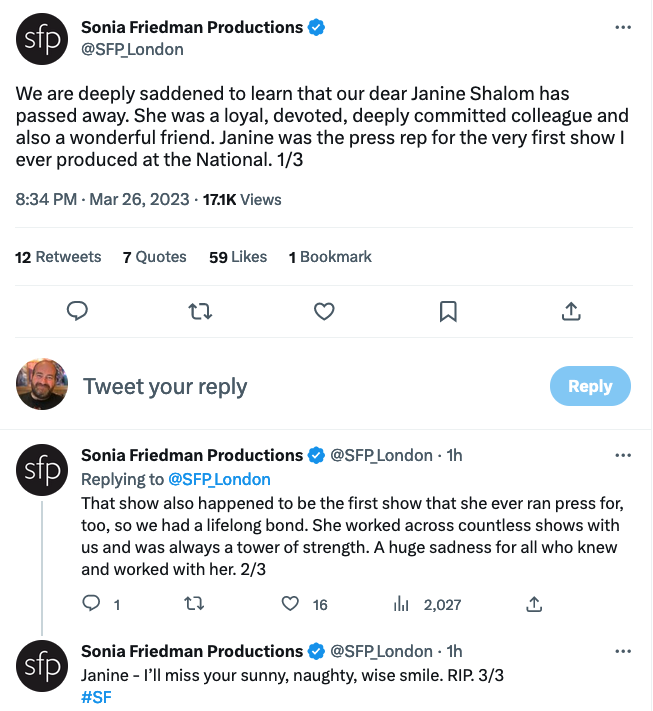
SHOWS AHEAD IN LONDON, SELECTED REGIONAL THEATRES AND ON BROADWAY
I’ve been unable to update my regular feature on upcoming shows in London, selected regional theatres and on Broadway, while my website continues to be offline (I made a foolish mistake of getting it updated and improved for mobile functionality, at which point it fell over entirely. If it ain’t broke, I should not have tried to fix it!)
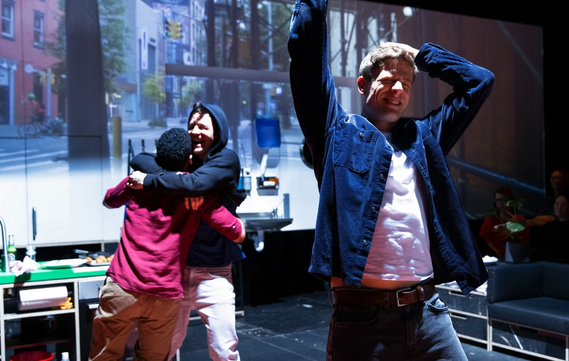
This week’s openings in London include a new musical about populist politician Berlusconi (opening at Southwark Playhouse on Wednesday), the English-language premiere of Ivo van Hove’s production of A LITTLE LIFE (pictured above, opening at the Pinter on Thursday) and a West End transfer for Ryan Calais Cameron’s For Black Boys Who Have Considered Suicide When The Hue Gets Too Heavy (opening at the Apollo on Friday). On Broadway, LIFE OF PI transfers from the West End, to open officially on Thursday at the Schoenfeld on west 45th Street.
See you here on Friday
I will be back on Friday, with my regular column The Week in Review(s) offering a day-by-day digest of the week in news and commentary of the previous seven days activity, including reviews of what I’ve seen and by others.
If you can’t wait that long, I may also be found on Twitter (for the moment) here: https://twitter.com/ShentonStage/ (though not as regularly on weekends)
